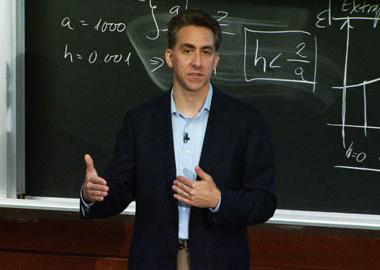 Knowing more about the environmental impacts of aviation is increasingly essential, but according to
Knowing more about the environmental impacts of aviation is increasingly essential, but according to Ian Waitz, it is also an area where uncertainties abound. One thing we know for sure is that the airplanes developed today will be flying for next 30 years, as the fleet dynamics are very stable, due to the extraordinary costs and lead-time to design and build. Meanwhile, an increasingly affluent population will travel more, and more of that travel will take place on today’s airplanes.
Waitz and his students have been developing state-of-the art modeling impacts, and advising the Federal Aviation Agency (FAA). He characterizes the environmental impacts of aviation into three broad categories. The most omnipotent impact, noise pollution, is associated with quality-of -life issues, health, and property loss. Waitz observes that noise pollution is observed by the public, typically at levels of 55 to 70 decibels. It is estimated to cost about half a billion dollars in property losses within the United States. The aviation industry is able to mitigate some of this burden on homeowners from a dedicated tax on ticket revenue.
A second environmental impact results from gaseous pollutants
that interact in the atmosphere, or more generically, “atmospheric chemistry and physics”. Unfortunately, the state-of-the -art has two known limitations: first, measurements are taken in conditions under 3000 feet, which is beneath airplane cruising levels. Second, long downwind effects of the pollutants are relatively unanalyzed, for example, down-winds that travel from Europe towards the East.
The third environmental impact, perhaps the best debated one, centers on global climate change. Waitz points out that there are many counterbalancing effects; for example, ozone creation may be a warming effect in the Northern Hemisphere but methane is a cooling effect globally. Scientists know that the largest non CO2 effects are created by contrails from aircraft that recombine as cirrus clouds. Yet, these clouds might either trap heat, or reflect it.
To date, government regulation of the airplane fleet has focused on reducing NOx, Even that is complicated, since more efficient fuels and engines can create more NOx. The FAA has strict guidelines to ratchet-down, over time, NOx produced by aircraft take-offs and landings. Waitz walks through the many projections, scenarios, and Monte Carlo simulations that underlie the government policy. He notes that whether or not there is complete information, decisions continue to be made, engine and fuel standards are set, and the environmental burden of aviation will continue to increase....Read the full article/Watch Video
The third environmental impact, perhaps the best debated one, centers on global climate change. Waitz points out that there are many counterbalancing effects; for example, ozone creation may be a warming effect in the Northern Hemisphere but methane is a cooling effect globally. Scientists know that the largest non CO2 effects are created by contrails from aircraft that recombine as cirrus clouds. Yet, these clouds might either trap heat, or reflect it.
To date, government regulation of the airplane fleet has focused on reducing NOx, Even that is complicated, since more efficient fuels and engines can create more NOx. The FAA has strict guidelines to ratchet-down, over time, NOx produced by aircraft take-offs and landings. Waitz walks through the many projections, scenarios, and Monte Carlo simulations that underlie the government policy. He notes that whether or not there is complete information, decisions continue to be made, engine and fuel standards are set, and the environmental burden of aviation will continue to increase....Read the full article/Watch Video
For more techical information visit our sister website www.engineeringmaintenance.info or for equipment procurement please visit www.engineeringtrader.com

